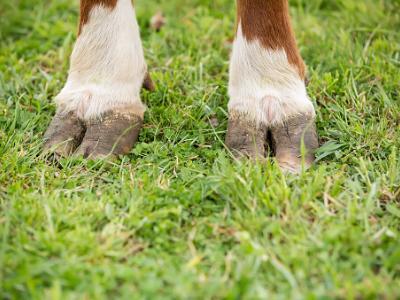Diseases of Cattle: Foot-and-Mouth

Foot-and-Mouth Disease is a severe, highly communicable disease of cattle, pigs, sheep, goats and deer. It is caused by one of the smallest disease producing viruses known. There are several different strains of the virus that cause the disease. The strain now in England and Europe is harder on pigs and cattle but milder in sheep and goats. Humans do not catch the virus. The disease is characterized by blister-like lesions on the tongue, nose and lips, in the mouth, on the teats and between the toes which then burst, leaving painful ulcers. The blisters cause a heavy flow of sticky, foamy saliva that hangs from the mouth. Infected animals sway from one foot to the other due to the tenderness of the feet. Although older cattle usually do not die from the infection, they suffer a severe illness which leaves them in a weakened state. They have high fevers, stop eating, give less milk and become lame.
The virus is extremely contagious and spreads rapidly unless it is contained. This usually requires quarantining infected farms, followed by slaughtering and burning all susceptible animals. Anyone having contact with animals in infected countries should not go near susceptible animals for at least five days. Because the virus is spread so easily, countries with the disease are banned from exporting animals and their products, creating further economic hardship. Foot-and-Mouth Disease was last seen in the United States in 1929. The U.S. Government places an extremely high priority on keeping the disease out of the country.
Related news
 Live yeast helps manage heat stress in dairy cows
Live yeast helps manage heat stress in dairy cows Rumen modifiers, such as live yeast, can help alleviate the drawbacks of heat stress on digestive comfort and help preserve dairy performance
 Crude protein levels low in 2016 silage crops
Crude protein levels low in 2016 silage crops Find out how to create the best quality silage. In the first and second cuts, average crude protein levels are 14.1 and 14.2 percent, respectively.
 Mycotoxins in corn silage threaten ruminant performance
Mycotoxins in corn silage threaten ruminant performance 2015 corn harvest found to have moderate to high risk levels of multiple toxins, calves especially susceptible